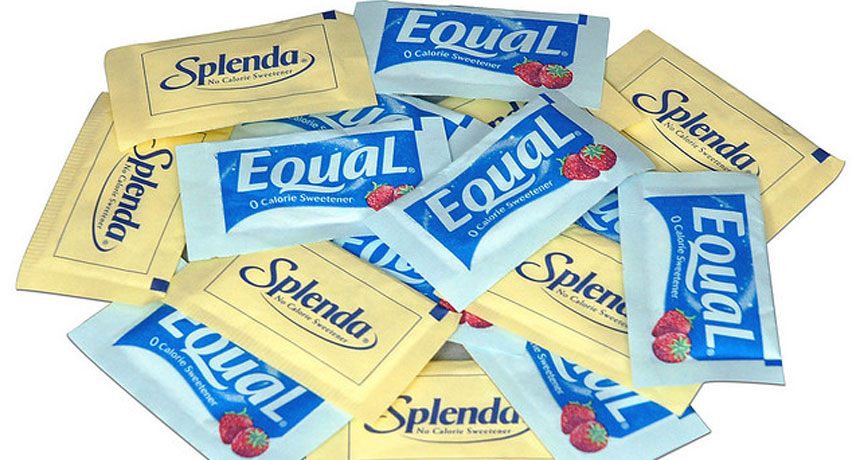Artificial sweeteners pollute streams
People excrete much of their foods’ fake sugar, which can end up bathing fish and other aquatic life

These popular fake sugars pass right through the body, making them calorie-free. But from there, some enter the environment where they persist as long-lived pollutants.
Bukowsky18/Flickr (CC BY-NC-SA 2.0)
By Janet Raloff
In the past few decades, diners have been turning increasingly to soft drinks and foods sweetened with fake sugar. The idea is to get the sweet taste without loading up on calories. But a new study finds an environmental cost to these sweeteners: In short order, they can end up polluting lakes and streams.
The human body tries to break down food into its raw materials. This helps extract any calories as energy. It also gives tissues the raw materials they need to grow. But our bodies largely ignore fake sugars. That’s why they don’t get converted to fat. Instead, they “are excreted mostly unchanged from the human body,” note Bikram Subedi and Kurunthachalam Kannan. They work for the New York State Department of Environmental Health Sciences in Albany.
After they are consumed, the artificial sugars are flushed out of the body and down the toilet. From there they flow to a sewage treatment plant. The purpose of these plants is to remove pollutants before the water is released into the environment once more. But water-treatment plants don’t remove all fake sugars from sewage equally well, the new data show.
Past studies have shown that water containing artificial sweeteners can harm a plant’s ability to perform photosynthesis. Plants use this process to produce food. Along the way, photosynthesis also releases oxygen into the air. As water pollutants, fake sugars also can alter the movements and body processes of water fleas. (These are not real fleas but rather teeny crustaceans known as Daphnia magna). The tiny animals serve as food for many fish. So fake sugars may not be safe for all organisms.
For their new study, Subedi and Kannan measured the amount of fake sugar in sewage entering two local water-treatment plants. Later, these chemists measured how remained in the water as it left those plants.
The treatment plants removed 75 percent of the aspartame in water. (This sweetener is sold in blue packets as Equal). Those plants also got rid of 90 percent of the saccharin (sold in pink packets as Sweet’N Low).
But the plants didn’t do nearly as well with two other fake sugars. Ninety-eight percent or more of sucralose passed right through the cleanup plants and out the other end, the study found. (This sugar substitute is sold in yellow packets under the name Splenda.) This chemical could then flow into rivers, lakes or the ocean. Treatment plants proved equally poor at removing acesulfame. (Supermarkets sell it as Sunett or Sweet One. Some companies also include it in sweetener blends, along with Splenda.)
Water-treatment plants had a hard time removing the excreted fake sugars that dissolve especially well in water, such as Splenda and Sunett. That now appears to explain why some studies have found traces of these fake sugars not only in stream water but also in drinking water.
Subedi and Kannan’s new data appeared online November 3 in Environmental Science & Technology.
Power Words
calorie The amount of energy needed to raise the temperature of 1 gram of water by 1 °C. It is typically used as a measurement of the energy contained in some defined amount of food.
chemical A substance formed from two or more atoms that unite (become bonded together) in a fixed proportion and structure. For example, water is a chemical made of two hydrogen atoms bonded to one oxygen atom. Its chemical symbol is H2O.
chemistry The field of science that deals with the composition, structure and properties of substances and how they interact with one another. Chemists use this knowledge to study unfamiliar substances, to reproduce large quantities of useful substances or to design and create new and useful substances. (about compounds) The term is used to refer to the recipe of a compound, the way it’s produced or some of its properties.
crustaceans Hard-shelled water-dwelling animals including lobsters, crabs and shrimp.
Daphnia magna Also known as water fleas, these are actually small, freshwater crustaceans. They are near the bottom of the food chain, serving as a major energy source for many small fish.
excrete To remove waste products from the body, such as in the urine.
photosynthesis (verb: photosynthesize)The process by which green plants and some other organisms use sunlight to produce foods from carbon dioxide and water.
pollutant A substance that taints something — such as the air, water, our bodies or products. Some pollutants are chemicals, such as pesticides. Others may be radiation, including excess heat or light. Even weeds and other invasive species can be considered a type of biological pollution.
saccharin A no-calorie sugar substitute.
sewage Wastes — primarily urine and feces — that are mixed with water and flushed away from homes through a system of pipes for disposal in the environment (sometimes after being treated in a big water-treatment plant).







